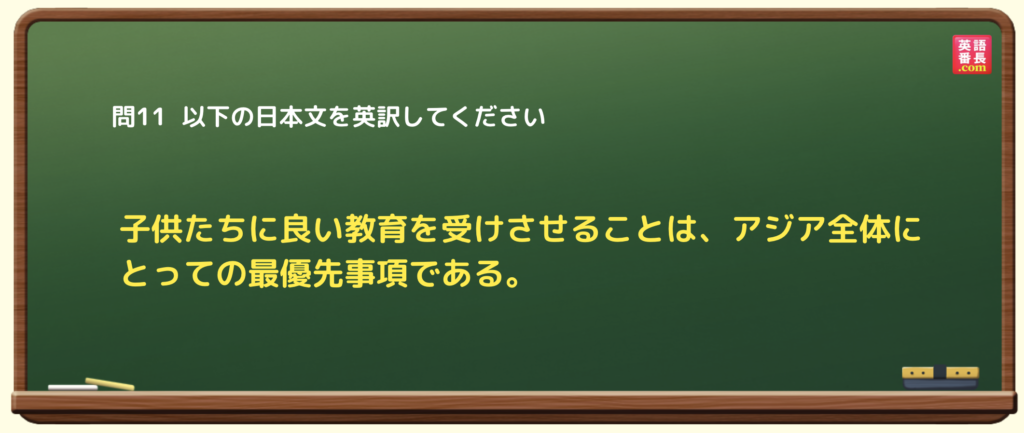
 番長先生
番長先生まずは〈公式〉を確認しよう!
公式
「子どもたちに良い教育を受けさせる」
① give(V) children(O1) a good education(O2)
② enable(V) children(O) to get a good education(to do O’)
③ make(V) it(O) possible(C) for children to get a good education(for S’ to do)
② “enable O to do ~” は「Oが〜するのを可能にする」の意味です。
③ “make it possible for S’ to do ~” は「S’が〜することを可能にする」の意味です。
“Let(Let) children(O) get a good education(do -)” は不可です。
使役動詞 “let O do -” 「Oに〜させる」は「〜を阻止しない・〜を邪魔しない」という消極的な意味の「許可」です。
この問題文のように「努力して〜を実現する」という意味では使えません。



次に〈語句〉を確認しよう!
語句 その1
「アジア全体」
① Asia as a whole
② all Asian countries
③ all (of) Asia
④ the whole of Asia
① “名詞 as a whole” は「〜全体」の意味です。
② “all 名詞” や ③ “all (of) the[one’s] 名詞” は個々の要素を考えながら全体を表す時の表現です。
一方、”the whole 名詞” は全体を1つのまとまりとして考える時の表現です。
“④ the whole of 抽象名詞・固有名詞” は「〜全体・〜全部」の意味です。
「国」や「地域全体」など 固有名詞 を表す場合は “× whole Asia” ではなく、”○ the whole of Asia” と表現します。
語句 その2
「最優先事項」
① the top[first / highest] priority
② the most important thing
③ most important
① priority は「優先事項」の意味です。
ちなみに “priority” は可算名詞です。
「優先順位が高い事項」は “a high priority”
「優先順位が低い事項」は “a low priority” と表現します



解答例を確認しよう!
Giving children a good education(S) is(V) the top priority(C) for Asia as a whole.
“giving children a good education” 「子供に良い教育を与えること」は動名詞で主語の働きをしています。
“for Asia as a whole” 「アジア全体にとっての」は形容詞の働きをしています。
直前の “the top priority” にかかっています。
Enabling children to get a good education(S) is(V) most important(C) for all Asia countries.
“enable O to do ~” 「Oが〜するのを可能にする」を使いました。
最上級 “most important” に “the” は必要ありません。
定冠詞 “the” は「後ろに名詞が続く」という印なので、(後ろに名詞が続かない)形容詞の最上級に “the” は必要ありません。
“for all Asia countries” 「アジア全体にとって・全てのアジアの国々にとって」は副詞の働きをしています。
直前の “most important” にかかっています。
It(S) is(V) the top priority(C) for the whole of Asia to give children a good education(for S’ to do).
“It is C for S’ to do -” で「S’が〜することはCである」の意味です。
“for the whole of Asia to give children a good education” で「アジア全体が子供たちに良い教育を受けさせること」の意味になります。
不定詞 to do ~ の前の “for S'” のことを「不定詞の意味上の主語」と言います。



次、行ってみよう!

